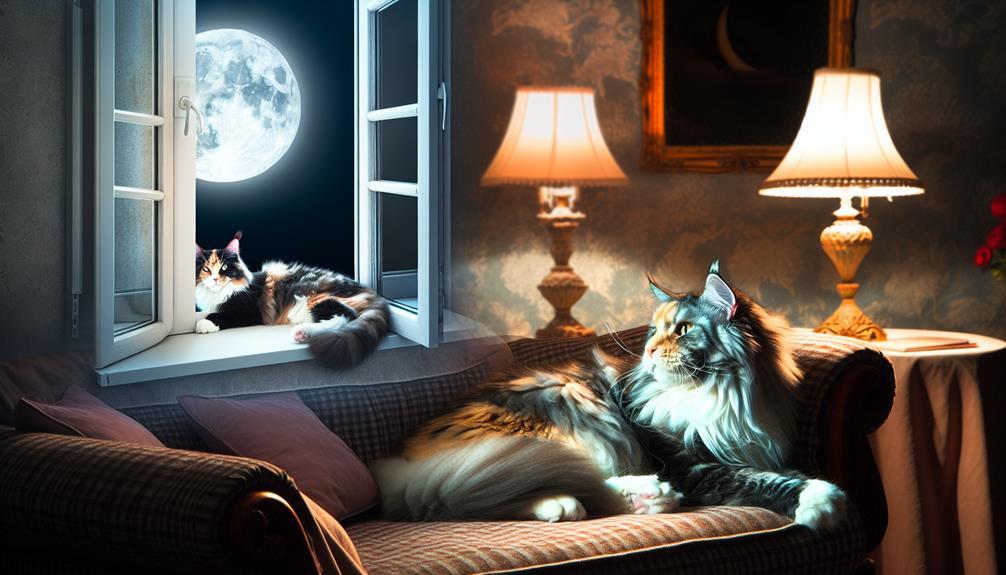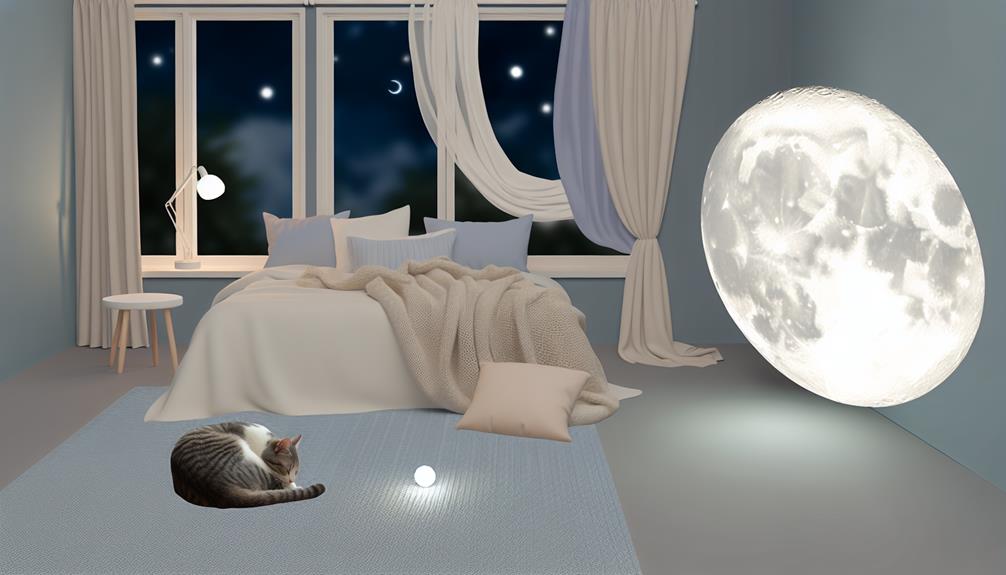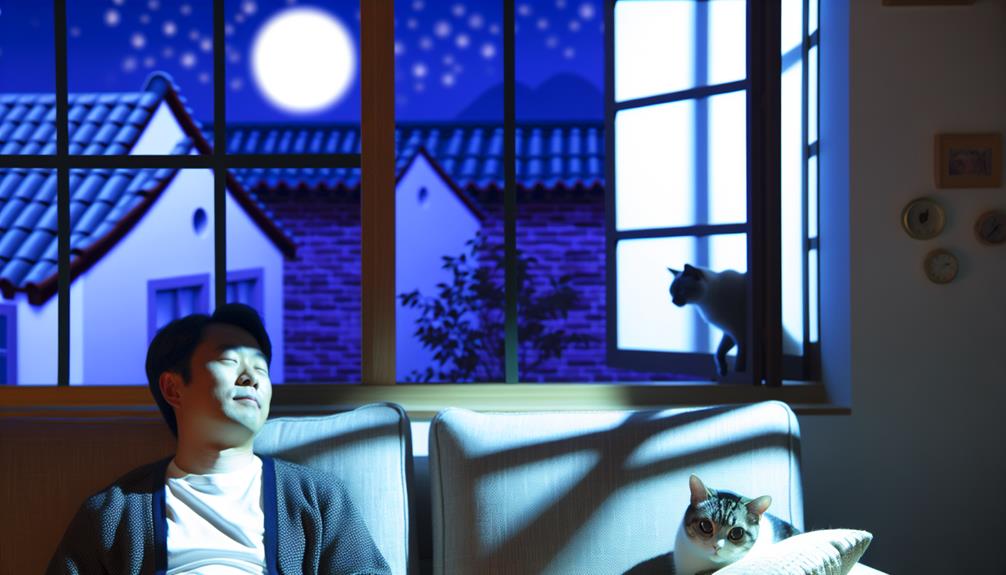You might have wondered why your house cat seems to come alive just as you're winding down for the night. Are cats truly nocturnal, or is there more to their activity patterns? It's fascinating to contemplate that while house cats aren't strictly nocturnal, they exhibit what's known as crepuscular behavior—being most active during dawn and dusk. This ties back to their natural hunting instincts, but domestication has its own influence. Understanding these patterns can be key to managing those nighttime antics. Curious about how to achieve nighttime peace with your feline friend?
Understanding Cat Sleep Patterns
When you explore the sleep patterns of house cats, you'll quickly notice that they don't adhere to the same sleep schedule as humans. Unlike humans, who typically have one consolidated period of sleep, cats exhibit polyphasic sleep patterns. This means they sleep multiple times within a 24-hour period. On average, a house cat sleeps between 12 to 16 hours a day, and sometimes even longer.
Understanding these sleep cycles is crucial to grasping feline behavior. Cats experience two main stages of sleep: slow-wave sleep (SWS) and rapid eye movement (REM) sleep. SWS is a lighter stage of sleep, during which a cat can wake up quickly if needed. REM sleep, on the other hand, is deeper and associated with dreaming. During REM, you might observe your cat twitching or making little sounds, which indicates that they're processing experiences similar to humans.
Feline instincts play a significant role in these sleep patterns. In the wild, cats are both predators and prey. As a result, their sleep cycles have evolved to guarantee they stay alert to potential threats while also being ready to hunt. This dual role requires them to have frequent, short naps rather than extended periods of deep sleep. Even though house cats don't face the same dangers as their wild counterparts, these ingrained instincts persist.
You might wonder why your cat seems to sleep so much during the day and becomes more active at dawn and dusk. This pattern is a reflection of their evolutionary history and the natural sleep cycles that have been passed down through generations. Understanding these behaviors provides insight into the complex nature of feline instincts.
Crepuscular Behavior Explained
Crepuscular behavior, a term rooted in zoological studies, describes the activity pattern observed in house cats where they're most active during the twilight hours of dawn and dusk. This behavior is driven by their crepuscular activity, a trait inherited from their wild ancestors. Your cat's heightened energy levels during these times are not a coincidence but rather a reflection of their natural hunting instincts.
House cats' crepuscular activity aligns with the ideal periods for hunting in the wild. Prey animals like rodents are also most active during dawn and dusk, making these the perfect times for your cat to be on the prowl. This behavior can be analyzed through the lens of evolutionary biology, where survival and efficiency in hunting are paramount.
Let's take a closer look at the typical behavior patterns associated with crepuscular activity:
| Time of Day | Typical Cat Behavior |
|---|---|
| Dawn | High activity, hunting-like behaviors |
| Morning | Reduced activity, rest |
| Dusk | High activity, playfulness |
| Evening | Gradual decline in activity |
| Night | Rest, occasional roaming |
Understanding this pattern can help you better cater to your cat's needs. During dawn and dusk, you might notice your cat engaging in playful or hunting-like behaviors, such as pouncing on toys or chasing imaginary prey. These activities are not just for fun; they are deeply ingrained hunting instincts.
Impact of Domestication

The impact of domestication on house cats has markedly altered their natural behaviors, though some wild instincts remain intact. Over thousands of years, cats have adapted to living alongside humans, and these changes are evident in their daily routines and interactions. Domestication effects can be observed in various aspects of cat behavior, including their sleeping patterns, hunting instincts, and social dynamics.
In the wild, cats are solitary hunters, primarily active during dawn and dusk—known as crepuscular behavior. However, when you bring a cat into a domestic environment, their activity patterns often shift to align more closely with human schedules. This adaptation is a direct result of domestication. For instance, you might notice your cat sleeping more during the day and being more active in the early morning or evening, but they also tend to adjust their activities to match your own daily routines.
Another significant change due to domestication effects is the reduction in the need to hunt for food. While your cat may still exhibit hunting behaviors like stalking and pouncing, the necessity to catch prey for survival is diminished. Instead, these behaviors are often redirected towards toys or play activities. This shift can affect their overall activity levels and energy expenditure.
Social behavior is another area where domestication has left a mark. While wild cats are typically solitary, domestic cats can form strong bonds with humans and other animals. They've become more adaptable in their social interactions, often seeking out human companionship and displaying affection in ways that their wild counterparts wouldn't.
Understanding these domestication effects can help you better appreciate the unique blend of wild instincts and adaptive behaviors that characterize your house cat.
Nighttime Activities
Although domestication has markedly influenced the behavior and daily routines of house cats, some of their primal instincts remain, particularly noticeable in their nighttime activities. When the sun sets, you might observe your feline companion engaging in behaviors reminiscent of their wild ancestors. These activities often revolve around night hunting and playful antics, which are ingrained in their DNA.
House cats, despite their domestication, retain a strong predatory drive. At night, their exceptional vision and acute hearing make them adept hunters. You may notice your cat stalking shadows or pouncing on imaginary prey. This night hunting behavior is a throwback to their wild relatives, who are crepuscular or nocturnal hunters, taking advantage of reduced competition and increased prey availability during these hours.
Playful antics are another common nighttime activity. Cats are known for their bursts of energy, often referred to as the "zoomies," which typically occur during twilight hours. These episodes mimic the pursuit and capture of prey, allowing them to expend their pent-up energy and sharpen their hunting skills.
Here are some nighttime behaviors you might observe:
- Stalking and pouncing: Your cat might chase small objects or even your feet, simulating a hunt.
- Chirping and chattering: These sounds often indicate that your cat is fixated on something, possibly an insect or a moving shadow.
- Scratching and climbing: Engaging in these activities helps them stretch their muscles and maintain their claws.
- Patrolling the house: This behavior mimics territorial checks, ensuring their environment is secure.
Understanding these behaviors can help you appreciate the deep-rooted instincts driving your cat's nighttime activities.
Tips for Nighttime Peace

If your cat's nighttime activities are disrupting your sleep, there are several strategies you can implement to promote a more peaceful household after dark. Establishing consistent nighttime routines and creating quiet environments can greatly reduce nocturnal disturbances.
Engage in Evening Playtime: Stimulating your cat with interactive play sessions in the evening can help expend their energy. Use toys that mimic prey, like feather wands and laser pointers, to tap into their natural hunting instincts.
Provide a Late-Night Meal: Feeding your cat a substantial meal before your own bedtime can encourage them to sleep through the night. Cats often sleep after eating, so a late-night meal can be beneficial.
Create a Quiet Sleeping Environment: Make sure your cat has a comfortable and quiet place to sleep. This could be a cozy bed in a secluded part of the house. Reducing noise and light in this area can be essential.
Ignore Nighttime Attention-Seeking: If your cat wakes you up for attention, try not to reinforce this behavior by responding. Ignoring them can eventually teach them that nighttime is not playtime.
| Strategy | Description |
|---|---|
| Evening Playtime | Engage your cat in interactive play to expend energy |
| Late-Night Meal | Feed your cat a substantial meal before bedtime |
| Quiet Sleeping Environment | Provide a comfortable, secluded, and quiet sleeping area for your cat |
| Ignore Attention-Seeking | Avoid reinforcing waking behavior by not responding to nighttime demands |
Conclusion
To sum up, understanding that house cats aren't strictly nocturnal but exhibit crepuscular behavior can be the key to a peaceful night. Their dawn and dusk activity is a dance with their wild instincts, influenced by domestication. By recognizing this, you're not just managing behavior; you're embracing their nature. Implementing strategies like interactive play before bedtime can calm their nighttime antics, ensuring both you and your feline friend have restful nights. Remember, knowledge is power, and peace.
